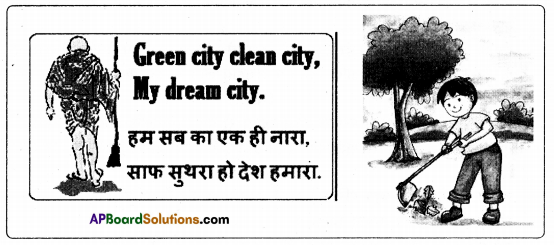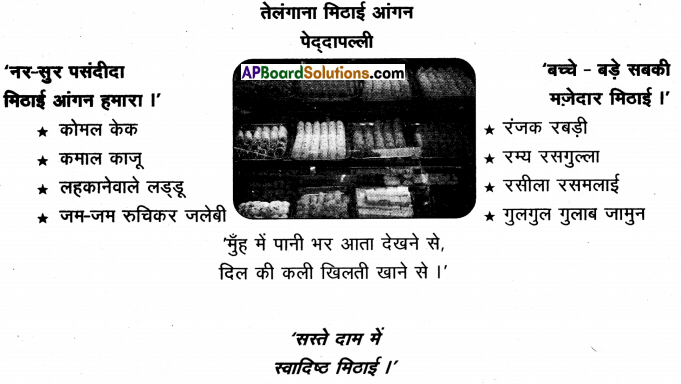Reviewing TS 10th Class Telugu Model Papers Set 1 can help students identify areas where they need improvement.
TS SSC Telugu Model Paper Set 1 with Solutions
‘సమయం: 3 గం.
మార్కులు : 80
విద్యార్థులకు సూచనలు :
- జవాబులు రాయడానికి 2 గంటల 30 నిముషాలు ఉపయోగించాలి.
- పార్ట్ ‘బి’ చివరి 30 నిమిషాలలో పూర్తిచేసి, పార్ట్ ‘ఎ’ జవాబు పత్రానికి జతచేయాలి.
పార్ట్ – A
I. అవగాహన – ప్రతిస్పందన (20 మార్కులు)
అ) కింది పేరాను చదవండి. ఇచ్చిన ప్రశ్నలకు జవాబులు 1, 2 వాక్యాలలో రాయండి. (5 × 1 = 5 మా.)
రాజాజ్ఞ మేరకు వశిష్ఠుడు మంత్రులను, అధికారులను, యువరాజ్యపట్టాభిషేక మహోత్సవానికి ఏర్పాట్లను చేయవలసిందని ఆదేశించాడు. దశరథుడు శ్రీరాముణ్ణి అక్కున జేర్చుకున్నాడు. బంగారు సింహాసనం మీద కూర్చోబెట్టాడు. చిరునవ్వులు చిందిస్తూ ‘రామా ! నీ సుగుణాలతో ప్రజలను మెప్పించావు కనుక నీవు యువరాజ పట్టాభిషేకం చేసుకోవాలి.
నీ బాధ్యత పెరుగుతున్నది. మరింత వినయవంతుడివి కావాలి జితేంద్రియుడివి కావాలి’ అంటూ రాజధర్మాలను నూరిపోశాడు. తండ్రి వద్ద సెలవు తీసుకొని తల్లి అయిన కౌసల్య దగ్గరికి వచ్చాడు శ్రీరాముడు. ఆమె ఆశీస్సులందుకున్నాడు. వశిష్ఠుని ఆదేశం మేరకు పట్టాభిషేకానికి అనువుగా సీతారాములు ఉపవాసదీక్షను గైకొన్నారు.
శ్రీరామ పట్టాభిషేక మహోత్సవం కోసం అయోధ్య తనను తాను అలంకరించుకుంది. నగరమంతా ఆనందశోభ తాండవిస్తున్నది. ఇది చూసిన మంథర కళ్ళలో నిప్పులు పోసుకున్నది. కైకేయి అత్తవారింటికి వచ్చినప్పుడు వెంట వచ్చిన అరణపుదాసి మంథర. పరుగు పరుగున కైకేయి దగ్గరికి వెళ్ళి పట్టాభిషేక విషయం చెప్పింది. కైకేయి చాలా ఆనందించి, వార్త చెప్పినందుకు మంథరకు విలువైన బహుమానాన్నందించింది.
నిశ్చేష్టురాలైంది. మంథర. “దుఃఖించవలసిన సమయంలో ఎందుకు సంతోషిస్తున్నా”వని నిలదీసింది కైకేయిని. “నాకు రాముడు, భరతుడు ఇద్దరూ సమానమే. రాముడు పట్టాభిషిక్తుడు అవుతున్నాడంటే అంతకన్నా నాకు ఆనందమేముంటుందన్నది కైకేయి.
ప్రశ్నలు :
ప్రశ్న 1.
దశరథుడు యువరాజ్య పట్టాభిషేకం ఎవరికీ చేయాలనుకున్నాడు ? ఎందుకు ?
జవాబు:
దశరథుడు యువరాజ్య పట్టాభిషేకం శ్రీరామునికి చేయాలనుకున్నాడు. రాముడు సుగుణాలతో ప్రజలను మెప్పించాడు. కనుక రామునికి యువరాజు పట్టాభిషేకం చేయాలి.
ప్రశ్న 2.
సీతారాములు ఉపవాసదీక్షను ఎందుకు తీసుకున్నారు ?
జవాబు:
సీతారాములు వశిష్ఠుని ఆదేశం మేరకు పట్టాభిషేకానికి అనువుగా ఉపవాస దీక్షను తీసుకున్నారు.
![]()
ప్రశ్న 3.
మంథర కైకేయిని ఏమని నిలదీసింది ?
జవాబు:
మంథర కైకేయిని ‘దుఃఖించవలసిన సమయంలో ఎందుకు సంతోషిస్తున్నావని’ నిలదీసింది.
ప్రశ్న 4.
అయోధ్య నగరం అలంకరించడానికి కారణమేమిటి ?
జవాబు:
శ్రీరామ పట్టాభిషేకం మహోత్సవ సందర్భంగా అయోధ్యను అలంకరించారు.
ప్రశ్న 5.
‘మంథర కళ్ళలో నిప్పులు పోసుకున్నది’ అంటే మీకేమి అర్థమైంది ?
జవాబు:
మంథర ఈర్ష్యాసూయలతో నిండిపోయింది.
ఆ) కింది పద్యాలలో ఏదైనా ఒక పద్యానికి ప్రతిపదార్థం రాయండి. (1 × 5 = 5 మా.)
6. నిండైన నిబంధమైన, ధరణీ నిర్మూలనంబైన, దు
ర్మరణం బైనఁ గులాంతమైన నిజమున్ రానిమ్ము; కానిమ్ము పో;
హరుఁడైనన్, హరియైన, నీరజభవుం డభ్యాగతుండైన నౌఁ;
దిరుగన్ నేరదు నాదు జిహ్వ; వినుమా ! ధీవర్య ! వేయేటికిన్ ?
జవాబు:
ప్రతిపదార్థం :
ధీవర్య = బుద్ధిమంతులలో శ్రేష్ఠుడా !
(ఓ శుక్రాచార్యా !)
నిరయంబైనన్
(నిరయంబు + ఐనన్) = నరకం దాపురించినా
నిబంధమైనన్ = బంధనం ప్రాప్తించినా.
ధరణీ నిర్మూలనంబైనన్;
ధరణీ = భూమండలం (రాజ్యం)
నిర్మూలనంబు + ఐనన్ = పూర్తిగా నశించినా (రాజ్య భ్రష్టుడయినా)
దుర్మరణంబైనన్ (దుర్మరణంబు + ఐనన్) = (విషం త్రాగడం వంటి కారణాల వల్ల మరణం సంభవించడం, దుర్మరణం)
కులాంతమైనన్ (కుల + అంతము + ఐనన్) = = (నా) వంశం అంతరించినా, (నా కులమునకు చేటు వాటిల్లినా)
నిజమున్ రానిమ్ము = నిజంగానే సంభవిస్తే సంభవించనీ !
(పైన చెప్పినట్లు నరకం, కారాగార బంధనం, రాజ్యభ్రష్ట, దుర్మరణం, వంశనాశనం, అనేవి నిజంగా నాకు వస్తే వచ్చుగాక !)
కానిమ్ము పో = ఏది జరిగితే, అదే జరుగనియ్యి
అభ్యాగతుండు = ఆ వచ్చిన అతిథి
హరుడైనన్
(హరుడు + ఐనన్) = ఈశ్వరుడైనా
హరియైనన్ = విష్ణుమూర్తియైనా
(హరి + ఐనన్)
నీరజభవుండు = పద్మ సంభవుడైన బ్రహ్మ
ఐనన్ = అయినా
ఔన్ = కావచ్చును;
విను = నా మాట వినండి
వేయి = వేయి మాటలు (పెక్కు మాటలు)
ఏటికిన్ = ఎందుకు ?
నాదు జిహ్వ = నా నాలుక
తిరుగన్ నేరదు = మారుమాట పలుకదు
(లేదా)
తెలగాణమ్మున గడ్డిపోచయును సంధించెన్ కృపాణమ్ము ! రా
జలలాముం డనువాని పీచమడచన్ సాగించె యుద్ధమ్ము! భీ
తిలిపోయెన్ జగమెల్ల యేమియగునో తెల్యంగరాకన్ ! దిశాం
చలముల్ శక్రధనుఃపరంపరలతో సయ్యాటలాడెన్ దివిన్
జవాబు:
ప్రతిపదార్థము :
తెలగాణమ్మునన్ = తెలంగాణలో
గడ్డిపోచయును = గడ్డిపోచకూడా ! (గడ్డిపరకవంటి అల్పుడు కూడా)
కృపాణమ్మున్ = కత్తిని
సంధించెన్ = చేతపట్టింది; (కత్తిపట్టి ఎదిరించాడు)
రాజలలాముండు = రాజశ్రేష్ఠుడు
అనువాని = అని పేరు పొందిన నిజాము నవాబు యొక్క.
పీచము = గర్వము (పొగరు)
అడచన్ = అణచడానికి
యుద్ధమ్మున్ = యుద్ధాన్ని (పోరాటమును)
సాగించెన్ = సాగించింది (వానితో యుద్ధం చేసింది)
యేమియగునో
(ఏమి + అగునో) = ఏమవుతుందో (యుద్ధం ఎలా పరిణమిస్తుందో)
తెల్యంగరాకన్ = తెలియకపోవడం వల్ల
జగమెల
(జగము + ఎల్ల)
భీతిలిపోయెన్ = భయపడిపోయింది
దివిన్ = ఆకాశమున
దిశాంచలముల్
(దిశా + అంచలముల్) = దిక్కుల చివరలన్నీ
శక్రధనుః పరంపరలతోన్;
శక్రధనుః = ఇంద్రధనుస్సు యొక్క
పరంపరలతోన్ = ఎడతెగని వరుసలతో
సయ్యాటలాడెన్ = కూడియాడాయి
ఇ) కింది పేరాను చదవండి. ఇచ్చిన ప్రశ్నలకు 1, 2 వాక్యాలలో జవాబులు రాయండి. (5 × 2 = 10 మా.)
జీవితంలో వేగం, దాంతో పాటు అవసరాలు పెరిగాయి. వాటిని తీర్చుకోవడానికి ఒక వస్తువు స్థానంలో పదేసి పోటీపడుతూ పుట్టుకొచ్చాయి. చిన్న ఉదాహరణ తీసుకుంటే దాహం తీర్చుకోవడానికి ఇంతకు పూర్వం మనం అవలంభించిన పద్ధతులకూ ఇప్పుడు వాడుకలో ఉన్న వాటికి ఎంతో తేడా కనిపిస్తుంది. ఒకప్పుడు ప్రయాణాల్లో కూజాలు, మరచెంబులూ, వాటర్ బ్యాగ్లూ లాంటివి ఉపయోగించే వాళ్ళు.
వాటి ప్రయోజనం ఒక తడవతో తీరిపోయేది కాదు. అదే వస్తువును ఎన్నిసార్లు ప్రయాణాలు చేసినా ఉపయోగించడం కద్దు. కానీ ప్రస్తుతం ఆ పద్ధతికి కాలదోషం పట్టింది. కూజానో, మరచెంబునో, చివరకు వాటర్ బ్యాగ్ ్న మోసుకెళ్ళడం, కారణాలేవైనా కష్టతరమనిపిస్తుంది. కొందరికి అది ఇబ్బందిగా కనిపిస్తే మరికొందరికి నామోషీగా మారిపోయింది. ఫలితంగా ‘యూజ్ అండ్ త్రో’ అనే సంస్కృతి ప్రాచుర్యం లభించింది.
దాహం తీర్చుకోవడానికి ఇంటి నుండి నీళ్ళు మోసుకుపోనవసరం లేదు. లేదా ఎక్కడో కుళాయి దగ్గర నీళ్ళు పట్టుకోవాల్సిన అగత్యమూ లేదు. దుకాణాల్లో నీళ్ళ బాటిళ్ళు అమ్ముతారు. వాటిని కొనుక్కొని తాగవచ్చు. అంతవరకు బాగానే ఉంది. ఆ తరువాత ఖాళీ బాటిల్ మాట ఏమిటని ఆలోచించేవాళ్ళ సంఖ్య స్వల్పం.
ఆ ప్లాస్టిక్ సీసాల్ని పదిలపరచి మళ్ళీ ఉపయోగించే వాళ్ళకన్నా చెత్తకుప్పల్లో పారబోసి వ్యర్థపదార్థాల్ని పెంచి పోషించేవారి సంఖ్య ప్రపంచ వ్యాప్తంగా అధికంగా ఉంటోందని పర్యావరణ ఉద్యమకారులు అంటున్నారు. ఇది నీళ్ళకే కాదు అనేక ద్రవ, ఘన పదార్థాలకూ వర్తిస్తుంది. మజ్జిగ కోసం, పాలకోసం, నూనె, నెయ్యి, వెన్న లాంటి పదార్థాల కోసం ఉపయోగించే పాలిథీన్ సంచులు. అవసరం తీరిన తరువాత వ్యర్థపదార్థాల రూపంలో ప్రాణాంతకంగా పరిణమిస్తున్నాయని పరిశోధనలో వెల్లడయింది.
ప్రశ్నలు :
ప్రశ్న 7.
ప్రయాణాలలో నీటి కోసం ఇంతకు పూర్వం ఏవి ఉపయోగించేవారు ?
జవాబు:
కూజాలు, మరచెంబులూ, వాటర్బ్యాగ్లు లాంటివి ఉపయోగించేవాళ్ళు.
![]()
ప్రశ్న 8.
యూజ్ అండ్ త్రో అనే సంస్కృతికి ఎందుకు ప్రాచుర్యం లభించింది ?
జవాబు:
కూజానో, మరచెంబునో, చివరకు వాటర్ బ్యాగ్ మోసుకెళ్ళడం వంటివి కొందరికి ఇబ్బందిగా కనిపిస్తే, మరికొందరికి నామోషీగా మారిపోయింది. ఫలితంగా ‘యూజ్ అండ్ త్రో’ అనే సంస్కృతికి ప్రాచుర్యం లభించింది.
ప్రశ్న 9.
ప్రస్తుతం ప్రయాణాలల్లో దాహం ఎలా తీర్చుకుంటున్నారు ?
జవాబు:
ప్రస్తుతం ప్రయాణాలలో దుకాణాల్లో నీళ్ళబాటిళ్ళు కొనుక్కుంటున్నారు. అలా దాహం తీర్చుకుంటున్నారు.
ప్రశ్న 10.
ప్రాణాంతకంగా పరిణమిస్తున్న వ్యర్థపదార్థాలు ఏవి ?
జవాబు:
పాలిథీన్ సంచులు
ప్రశ్న 11.
ఈ పేరా ఏ అంశం పైన రాయబడింది ?
జవాబు:
ప్రాణాంతకంగా మారిన పాలిథీన్ సంచుల గురించి.
II. వ్యక్తీకరణ – సృజనాత్మకత
అ) కింది ప్రశ్నలకు 5 నుండి 6 వాక్యాలలో జవాబులు రాయండి. (4 × 3 = 12 మా.)
ప్రశ్న 12.
నగరంలో ‘తీరిక దక్కదు, కోరిక చిక్కదు’ అని కవి ఎందుకన్నాడు ?
జవాబు:
నగరవాసులకు తీరిక ఉండదు. నగరంలో ఉద్యోగాలు చేసేవారు ఉదయమే బయలుదేరి దూరంగా ఉన్న తమ కార్యాలయాలకు, ఉరుకులు, పరుగులూ పెడుతూ పొద్దున్నే వెళ్ళాలి. ట్రాఫికామ్లుంటాయి. కాబట్టి ఆఫీసు వేళకు చాలా ముందుగానే వారు ఇంటి నుండి బయలుదేరాలి. తిరిగి ఇండ్లకు వచ్చేటప్పటికి పొద్దుపోతుంది.
అలాగే నగరంలో కూలిపనులు చేసి జీవించే వారికి కూడా, వారికి పని దొరికే ప్రాంతానికి రావడానికీ, పోవడానికీ ఎంతో సమయం పడుతుంది. అందుచేత వారికి కూడా తీరిక దక్కదు.
ప్రశ్న 13.
వీరతెలంగాణ పాఠ్యాంశ కవిని గురించి రాయండి.
జవాబు:
‘వీరతెలంగాణ’ పాఠాన్ని దాశరథి కృష్ణమాచార్యులు రచించారు. ఈయన వరంగల్లు జిల్లా చిన్నగూడూరులో జిన్మించారు. వీరు
- అగ్నిధార
- రుద్రవీణ
- మహాంధ్రోదయం
- పునర్నవం
- కవితాపుష్పం
- తిమిరంతో సమరం
- అమృతాభిషేకం
- ఆలోచనాలోచనాలు వంటి కవితా సంపుటాలను వెలువరించారు.
వీరు
- నవమి (నాటికలు)
- యాత్రా స్మృతి అనే స్వీయచరిత్రను వ్రాశారు. వీరు సినీ గేయ కవిగా, ఆణిముత్యాల వంటి పాటలు రాశారు. గాలిబ్ గజళ్ళను 1961లో తెలుగులోనికి వీరు అనువదించారు. 1967లో ఆంధ్రప్రదేశ్ సాహిత్య అకాడమీ అవార్డునూ, 1974 కేంద్ర సాహిత్య అకాడమీ అవార్డునూ వీరు పొందారు.
ప్రశ్న 14.
‘ఆడవాళ్ళ నోట అసలైన భాష ఉంటుందని’ సామల సదాశివ ఎందుకు అన్నాడు ?
జవాబు:
‘ఆడవాళ్ళ నోట నుండే అసలైన భాషను వినగలం’ అనే మాటను, నేను సమర్థిస్తాను. ఆడవాళ్ళ మాటల్లో కల్తీ ఉండదు. వారు ఇంటిపట్టునే ఉంటారు. కనుక, వారు మాట్లాడే భాషలో ఇతర భాషా పదాలు కలియవు. అందుకే ఆడవాళ్ళ నోట అసలైన భాషను మనము వినగలం. అందుకు గల కారణాలు.
- వరంగల్లులో కూరగాయలు అమ్మే స్త్రీల మాటల్లో అచ్చమయిన తెలుగు నుడి వినిపిస్తుంది.
- అలాగే ఉర్దూ మాట్లాడే ముస్లిము స్త్రీలు, ఇల్లు దాటి వెళ్ళని వాళ్ళైన రాజమహల్లులో ఉండే బేగముల భాష, పరిశుద్ధమైనదని ఆ రోజుల్లో విద్వాంసులు చెప్పేవారు. అందుకే కల్తీ లేని ఉర్దూను, ‘బేగమాతీ జుబాన్’, ‘మహెల్లాతీ జుబాన్’ అని పిలిచేవారు.
ప్రశ్న 15.
“మనుషులంతా పుట్టుకతో సమానం” అని ఎందుకు అనవచ్చునో రాయండి.
జవాబు:
ప్రజలలో ధనిక-పేద, ఎక్కువ తక్కువ భేదాలు ఏవీ పుట్టినపుడు లేవు. పుట్టేటప్పుడు అందరూ ఒకేలాగా పుడతారు. కానీ తరువాతే కుల, మత, వర్ణ, జాతి, వర్గ, ధనిక, పేద తారతమ్యాలు, ఆధిక్యం -న్యూనతాభావాలు ఏర్పడతాయి. నిమ్నజాతుల అభ్యున్నతికి, సమాజ శ్రేయస్సుకు తోడ్పడే భాగ్యరెడ్డి వర్మ అణగారిన వర్గాల్లో ఆ న్యూనతా భావం పొగొట్టి ఆది ఆంధ్రులుగా వారిని నమోదు చేయించాడు. దీన్ని బట్టి మనుషులంతా పుట్టుకతో సమానులే. ఎట్లాంటి ఎక్కువ ‘తక్కువ భావాలేవీ ఉండవని తెలుస్తుంది.
ఆ) కింది ప్రశ్నలకు 10 నుండి 12 వాక్యాలలో జవాబులు రాయండి. (3 × 7 = 21 మా.)
ప్రశ్న 16.
దానశీలం పాఠం ఆధారంగా బలిచక్రవర్తి స్వభావాన్ని వివరించండి.
జవాబు:
గురువు శుక్రాచార్యుడు దానము వద్దని చెప్పినా బలి దానానికి సిద్ధపడటం అతని దాన గుణాన్ని తెలియచేస్తుంది. వామనునికి ఇచ్చే దానం వలన బలి మరణిస్తాడని గురువు శుక్రాచార్యుడు చెప్పాడు. కాని బలి చక్రవర్తి కీర్తి కోసం అంతటి త్యాగానికి సిద్ధపడ్డాడు. కనుక బలి చక్రవర్తి ఏ త్యాగానికైనా వెనుకాడని స్వభావం (గుణము) కలవాడని మనకు తెలుస్తుంది.
గురువు చెప్పినా వినకుండా, ఆడినమాట తప్పకుండా, బలిచక్రవర్తి దానం చేశాడు. అందువల్ల బలి చక్రవర్తి ఆడిన మాట తప్పని గుణం కలవాడని చెప్పవచ్చు. గత కాలంలోని శిబి చక్రవర్తి వంటి దాతలను గమనించి, ఆనాటి త్యాగధనులను ఆదర్శంగా ఎంచుకొనే గుణం కలవాడు. దానం ఆశించేవారు రాక్షస విరోధియైన విష్ణుమూర్తి అయినా దానం చేయడానికి వెనుకాడకపోవడం బలిచక్రవర్తిలోని దానగుణాన్ని తెలియజేస్తుంది.
(లేదా)
జీవనభాష్యం మనకు ఎలాంటి ప్రేరణను కలిగిస్తుందో రాయండి.
జవాబు:
సి. నారాయణరెడ్డి మానవ వికాసానికి జీవనభాష్యం అన్న గజల్సులో ఇలా నీటితో నిండిన మబ్బులు తేమతో బరువు ఎక్కితే వర్షంగా కురుస్తాయి. అలాగే మనస్సుకు దిగులు మబ్బులు కమ్మితే అది కన్నీరుగా అవుతుంది.
“ఒక లక్ష్యాన్ని సాధించడానికి బయలుదేరినపుడు ఎన్నో కష్టాలూ, అడ్డంకులూ ఎదురౌతాయని లోకం భయపెడుతుంది. ఆ మాటలకు మనం భయపడకుండా ముందుకు నడిస్తే విజయం లభిస్తుంది. క్రమంగా అదే నలుగురికీ దారిగా మారుతుంది. బీడునేలల్లో ఏ పంటలు పండవని, ఏ ప్రయత్నం చేయకుండానే నిరాశపడవద్దు. కష్టపడి ఆ నేలను దున్ని విత్తులు నాటితే, ఆ నేలలో మంచి పంటలు పండుతాయి.
నలుగురు మనుషులు కలసి జీవించడం మంచి సాఘిక జీవనం. సాటివారి పట్ల మనం సానుకూల దృక్పథాన్ని ఏర్పరచుకోవాలి. అటువంటి మనుష్యులు కలిస్తేనే అది ఊరు అవుతుంది.
ఎన్ని విజయాలు సాధించినా, ఎంత ఎత్తుకు ఎదిగినా విధి ఏ పరీక్షలు పెడుతుందో ఎవరూ ముందుగా ఊహించలేరు. విధి శక్తి ముందు అందరూ తలవంచాలి. ఎత్తైన హిమాలయ పర్వతం కూడా ఎండ వేడికి కరిగి నీరు కావలసిందే కదా!
మంచి పేరు పొందామనీ, బిరుదులూ, సత్యారాలు పొందామనీ అనుకోవడంలో విలువ, గుర్తింపు లేదు. మానవాళికి ఉపయోగించేలా నిస్వార్థ త్యాగం చేస్తేనే ఆ మనిషి పేరు చరిత్రలో శాశ్వతంగా నిలుస్తుందని సి.నా.రె. మనకు ప్రేరణ కల్గించాడు.
![]()
ప్రశ్న 17.
కొత్తబాట పాఠం ఆధారంగా పల్లెలో అక్క గుర్తించిన మార్పులు ఏమిటో వివరించండి.
జవాబు:
పూర్వం పల్లెల్లో భూస్వాములు సన్న, చిన్నకారు రైతులపై పెత్తనం చెలాయిస్తూ ఉండేవారు. పేద ప్రజలు శ్రమపడి పంటలు పండిస్తే వారి శ్రమకు తగిన ప్రతిఫలం వారికి ఇవ్వకుండా, ఈ భూస్వాములు దోపిడీ చేసేవారు. అవసరానికి ‘ భూస్వాముల వద్ద అప్పుతీసుకుంటే వారికి వడ్డీలపై వడ్డీలు వేసి, పేద ప్రజల్ని పీడించేవారు. గ్రామంలో తక్కువ కులాల వారిని బానిసలుగా చూసేవారు. ఆ రోజుల్లో స్త్రీలు ధైర్యంగా బయటికి వచ్చే పరిస్థితి ఉండేదికాదు. కులమత భేదాలు దోపిడీలు, దౌర్జన్యాలతో భూస్వాములు పేద ప్రజల్ని హింసిస్తూ ఉండేవారు.
కానీ నేడు పరిస్థితుల్లో మార్పు వచ్చింది. ప్రజలు తెలివి తెచ్చుకుని, భూస్వాములపై తిరుగుబాటు చేశారు. వారి అధికారాన్ని ప్రశ్నించగలిగారు. ప్రజలంతా కలసి కట్టుగా ఉండి, కష్టపడి పనిచేసి సంపాదించిన సొమ్మును తింటూ, బానిసత్వం నుండి విముక్తిని పొందారు. అన్యాయాలను అరికట్టగలిగారు. స్త్రీలు బయటకు ధైర్యంగా వచ్చి వారి పనులు వారు చేసుకోగలుగుతున్నారు. పేద, ధనిక తేడాలు, కులమత భేదాలు లేకుండా అందరూ సమభావంతో కలసికట్టుగా, స్వేచ్ఛగా, సంతోషంగా ఉండగలుగుతున్నాడు.
(లేదా)
నిర్మాణపరంగా గోలకొండ పట్టణం యొక్క గొప్పతనాన్ని రాయండి.
జవాబు:
ఇబ్రహీం కుతుబ్షా అనే గోల్కొండ నవాబు, సర్దార్లను, భాగ్యవంతులను కోటలోనే మేడలు కట్టమని ఆజ్ఞ చేశాడు. దానితో గోల్కొండ పట్టణం, అలంకార భూయిష్టం అయ్యింది. పట్టణంలో అందమైన భవనాలు, దేవాలయాలు, మసీదులు, ధర్మశాలలు, భిక్షా గృహాలు కట్టారు. గోల్కొండ పట్టణంలో ‘నగీనాబాగ్’ అనే అందమైన ఉద్యానవనము ఉండేది. ‘షాషిమహలు’ అనే రాజుల మేడలు, ఆనాటి ఇంజనీర్ల ప్రతిభను తెలిపేవి.
అక్కడ ‘దిల్కుషా’ అనే భవనము, గొప్ప అందమైన రాజమందిరము. దీనిలో విదేశీ రాయబారులు బస చేసేవారు. యుద్ధ భటులకు రెండు బారకాసులు ఉండేవి. మి మీద తోటలు గోల్కొండ నగరంలో విలక్షణమైనవి. అందమైనవి. కటోరా హవుజు ప్రాంతము వేసవిలో గొప్పవారికి విహారభూమిగా ఉండేది. ఆఫ్రిగా నుండి తెప్పించిన ‘దొడ్డ బాల్బోవా’ వృక్షము, దానిలోని తొఱ్ఱ మంచి ఆకర్షణగా ఉండేది.
ప్రశ్న 18.
శ్రీరాముని గుణగణాలను వివరించండి.
జవాబు:
శ్రీరాముడు సకలగుణాభిరాముడు. శ్రీరాముడు, మారీచుడు చెప్పినట్లుగా ధర్మము మూర్తీభవించిన పుణ్యమూర్తి. రాముడు సత్యపరాక్రముడు. రాముడు రూపంలో, గుణంలో గొప్పవాడు. మహావీరుడు. మృదువుగా మాట్లాడతాడు. శరణన్న వారిని కాపాడతాడు. గర్వంలేనివాడు. పరుల సంపదను ఆశించడు. తల్లి దండ్రులయందు; గురువులందు భక్తి కలవాడు. ప్రజల పట్ల వాత్సల్యం కలవాడు. వినయశీలి. ప్రజలందరికీ రాముడంటే ప్రీతి.
శ్రీరాముడు మర్యాదా పురుషోత్తముడు. మాతృభక్తి కలవాడు. పితృభక్తి పరాయణుడు. పితృవాక్య పరిపాలకుడు. ఏకపత్నీవ్రతాన్ని పూనినవాడు. అఖండమైన సోదరప్రేమ కలవాడు. స్నేహితులైన సుగ్రీవ, విభీషణులపై ప్రేమ చూపి, వారిని రాజులుగా చేశాడు. రాముడు శరణాగతవత్సలుడు. ఆడినమాట తప్పనివాడు. మహా పతివ్రతయైన భార్య సీత యందు గొప్ప ప్రేమానురాగాలు కలవాడు. నేటికీ రామరాజ్యం కావాలని ప్రజలు కోరుకుంటున్నారు.
(లేదా)
రామాయణం ఆధారంగా గురుశిష్య సంబంధం గురించి రాయండి.
జవాబు:
పూర్వ కాలంలో ‘గురుముఖతః’ విద్య నేర్చుకునేవారు. గురుసేవలు చేసి, వాళ్ళ అనుగ్రహాన్ని పొంది విద్యలను అభ్యసించేవారు.
రామాయణాన్ని పరిశీలించినట్లయితే రామలక్ష్మణులు కూడా విశ్వామిత్రునికి సేవలు చేసి ఆయన వద్ద అనేక విద్యలను అభ్యసించినట్లు తెలుస్తోంది. విశ్వామిత్రుడు యాగరక్షణ కోసం బాలకులైన రామలక్ష్మణులను తనతో అడవికి తీసికోనిపోయి ‘బల’, ‘అతిబల’ వంటి విద్యలను బోధించాడు. వీటి ప్రభావం వల్ల అలసట, ఆకలి దప్పుల వంటివి ఉండవు. దీన్ని బట్టి శిష్యుల బాగోగులను చూడటం తమ బాధ్యతగా గురువులు గ్రహించే వారని తెలుస్తోంది.
రామాయణం ఆధారంగా పరిశీలిస్తే గురుశిష్యుల సంబంధం ఎంతో విశిష్టమైనదిగా తోస్తుంది. శిష్యులు గురువు ఆజ్ఞను పాటించడం తమ కర్తవ్యంగా భావించేవారు. తాటక వధ గావించిన రాముని చూసి సంతోషించి విశ్వామిత్ర మహర్షి రామునికి ఎన్నో దివ్యాస్త్రాలను అనుగ్రహించాడు.
గురువు అనుగ్రహిస్తే ఇవ్వలేనిది లేదనీ, శిష్యుడు పొందలేనిది లేదనీ రామాయణాన్ని బట్టి గ్రహించవచ్చును. గురువు శిష్యుల పట్ల వాత్సల్యంతోను, శిష్యులు గురువు పట్ల వినయ విధేయతలతోను మెలగుతండేవారు.
ఇ) సృజనాత్మకత (1 × 7 = 7 మా.)
ప్రశ్న 19.
చదువుకోవడం వల్ల కలిగే ప్రయోజనాల గురించి ఇద్దరు మిత్రుల మధ్య సంభాషణ రాయండి..
జవాబు:
రాము : రవీ ! ఈ రోజు నేను చదువు వలన లాభాలను తెలుసుకున్నానురా !
రవి : అవున్రా ! చదువుకోవడం వల్ల ముందు వినయం కల్గుతుంది. దాని తర్వాత ధనము, సౌఖ్యము కల్గుతాయని భర్తృహరి చెప్పాడు కదా !
రాము : ఏది మంచో, ఏది చెడో అన్న విచక్షణ కల్గుతుంది.
రవి : వివేకం ప్రధానంగా వస్తుంది.
రాము : ప్రపంచంలో జరిగే విషయాలు, దురలవాట్ల వలన కలిగే నష్టాలు తెలుస్తాయి.
రవి : చదువు వల్ల సమాజంలో గౌరవం లభిస్తుంది.
రాము : ఉపాధి దొరుకుతుంది.
రవి : చేసే పనిలో నైపుణ్యం పెరుగుతుంది.
రాము : ఆత్మ విశ్వాసం కల్గుతుంది. పైగా దొంగలు దోచుకోలేరు.
రవి : అంతేకాదురా అన్నదమ్ములు పంచుకోలేరు కదా !
రాము : చదువు వల్ల మనమిద్దరం మంచి విషయాలు తెలుసుకున్నామురా !
(లేదా)
మూఢనమ్మకాలను వదలిపెట్టాలని వివరిస్తూ కరపత్రం రాయండి.
జవాబు:
మూఢనమ్మకాలకు స్వస్తి పలుకుదాం
సోదర / సోదరీమణులారా !
మానవ సమాజంలో అనేక దురాచారాలు, మూఢ నమ్మకాలు అనాదిగా నెలకొనియున్నాయి. తర్వాతి తరాలవారు వాటిని గుడ్డిగా నమ్మారు. ఆ మూర్ఖత్వం నుండి, ఆ మూఢత్వం నుండి ఇంకను జాగృతం కాని మానవ సమాజం నేటికి కూడా మనకు కన్పిస్తుంది.
బాల్య వివాహాలు జరపడం, సతీ సహగమనాలు, అంటరానితనం. కూకటి వ్రేళ్ళతో పేరుకొనిపోయి ఉన్నాయి. ఇంకా దయ్యాలనీ, భూతాలనీ, చేతబడులనీ నేటికీ మానవాళి విశ్వసిస్తూనే ఉంది. కొన్ని ప్రాంతాలలో అయితే క్షుద్రశక్తుల్ని వశం చేసుకొనుటకు నరబలులు ఇస్తూనే ఉన్నారు. ఇటువంటి మూఢాచారాల్ని నశింపచేయాలి.
ఈ ఆధునిక యుగంలో ఈశ్వరచంద్ర విద్యాసాగర్, రాజారామమోహన్ రాయు, కందుకూరి వీరేశలింగం పంతులు వంటి సంఘ సంస్కర్తలు సతీ సహగమనాన్ని మాన్పించారు. బాల్య వివాహాల్ని నిర్మూలించారు. వితంతు వివాహాల్ని పునరుద్ధరింపచేశారు.
శకునం మంచిది కాదని, ఈ రోజు తిథి మంచిది కాదని, పనులు చేయడం ఆపేస్తున్నారు. ఇటువంటి మూఢనమ్మకాల నుండి ప్రజల్ని జాగృతం చెయ్యాలి.
భగవంతుని సృష్టిలో అందరూ సమానమే. మూఢ నమ్మకాల్ని తరిమి కొట్టండి. సాటిమనిషిని మనిషిగా గుర్తించి, మానవత్వాన్ని పరిమళింపచేయాలి. ఏమతమైనా మానవత్వం ఒక్కటే ! అని ఎలుగెత్తి చాటాలి.
ఇట్లు
నవయువత జాగృత పరిషత్
జడ్చర్ల
తేది : XXXXX
కాపీలు : 50,000
ముద్రణ : XXXXX
పార్ట్ – B
సమయం : 30 ని.లు
మార్కులు 20
సూచనలు :
- విద్యార్థులు జవాబులను ఈ ప్రశ్నాపత్రంలోనే నిర్దేశించిన విధంగా కేటాయించిన స్థలంలో రాయాలి.
- పూర్తి చేసిన ‘పార్ట్ – బి’ ప్రశ్నా పత్రాన్ని ‘పార్ట్ – ఎ’ జవాబు పత్రంతో జత చేయండి.
I. భాషాంశాలు (2 × 1 = 2 మా.)
అ) పదజాలం :
కింది పదాలను సొంతవాక్యాలలో ప్రయోగించండి.
ప్రశ్న 1.
చేతులొగ్గు: ………………………………………..
జవాబు:
చేతులొగ్గు : పెద్దలందు పిల్లలు చేతులొగ్గి నడచుకోవాలి.
ప్రశ్న 2.
మహమ్మారి : …………………………………….
జవాబు:
మహమ్మారి : ఇటీవల కరోనా మహమ్మారి వచ్చి ప్రజలను చంపింది.
![]()
కింది వానికి సరైన జవాబును గుర్తించి ఆ సంకేతాన్ని ( A / B / C / D) బ్రాకెట్లో రాయండి. (8 × 1 = 8 మా.)
ప్రశ్న 3.
ఝాన్సీ లక్ష్మీబాయి కృపాణం చేతబట్టి యుద్ధానికి బయలుదేరింది. (గీత గీసిన పదానికి అర్థాన్ని గుర్తించండి)
A) పుష్ప
B) కత్తి
C) గజ్జెలు
D) కర్ర
జవాబు:
B) కత్తి
ప్రశ్న 4.
తటాకంలో తామరపూలు విచ్చుకొని అందంగా కనబడుతున్నాయి. (గీత గీసిన పదానికి అర్థాన్ని గుర్తించండి)
A) చెరువు
B) బావి
C) నది
D) కాలువ
జవాబు:
A) చెరువు
ప్రశ్న 5.
“మహి” అనే పదానికి పర్యాయపదాలు
A) మరణం, చావు
B) మాట, వాక్కు
C) ఆది, మొదలు
D) భూమి, అవని
జవాబు:
D) భూమి, అవని
ప్రశ్న 6.
అమ్మ తొలి గురువు – గీత గీసిన పదానికి పర్యాయపదాలు
A) చివరి, ఆఖరి
B) మధ్య, నడుమ
C) ఆది, మొదలు
D) పిదప, మొదటి
జవాబు:
C) ఆది, మొదలు
ప్రశ్న 7.
హరి అనే పదానికి నానార్థాలు
A) సంపద, లక్ష్మి
B) విష్ణువు, సింహం
C) భీముడు, శివుడు
D) కోతి, దిక్కు
జవాబు:
B) విష్ణువు, సింహం
ప్రశ్న 8.
బంగారం, ఉమ్మెత్త అనే నానార్థాలు కల్గిన పదం
A) శునకం
B) కవి
C) రాజు
D) కనకం
జవాబు:
D) కనకం
ప్రశ్న 9.
పోతన కవితలో భక్తి ఉంటుంది. ఆ కైత శబ్దాలంకారాలకు పెట్టింది పేరు. ఈ వాక్యంలోని ప్రకృతి వికృతులు
A) కవిత, కైత
B) భక్తి, కైత
C) కవిత, పోతన
D) పేరు, భక్తి
జవాబు:
A) కవిత, కైత
ప్రశ్న 10.
‘భానుడు’ అనే పదానికి వ్యుత్పత్తి
A) భరించేవాడు
B) బాధించేవాడు
C) ప్రకాశించేవాడు
D) పవళించేవాడు
జవాబు:
C) ప్రకాశించేవాడు
ఆ) వ్యాకరణాంశాలు :
కింది వానికి సరైన జవాబును గుర్తించి ఆ సంకేతాన్ని ( A / B / C / D) బ్రాకెట్లలో రాయండి. (10 × 1 = 10 మా.)
ప్రశ్న 11.
అద్దానవేంద్రుడు విడదీసి రాస్తే
A) ఆ + దానవేంద్రుడు
B) అద్దాన + వేంద్రుడు
C) ఆ + దానవేంద్రుడు
D) అద్దా + నవేంద్రుడు
జవాబు:
C) ఆ + దానవేంద్రుడు
ప్రశ్న 12.
రుగాగమ సంధికి ఉదాహరణ
A) ధీరురాలు
B) కమలాక్ష
C) దేశౌన్నత్యం
D) పూర్ణోదయం
జవాబు:
A) ధీరురాలు
ప్రశ్న 13.
వనజముల వంటి నేత్రములు కలది – ఈ విగ్రహవాక్యం ఏ సమాసానికి చెందినది ?
A) ద్వంద్వ సమాసం
B) ద్విగు సమాసం
C) బహువ్రీహి సమానం
D) రూపక సమాసం
జవాబు:
C) బహువ్రీహి సమానం
ప్రశ్న 14.
‘రామలక్ష్మణులు’ ఏ సమాసం ?
A) ద్విగు సమాసం
B) ద్వంద్వ సమాసం
C) బహువ్రీహి సమాసం
D) రూపక సమాసం
జవాబు:
B) ద్వంద్వ సమాసం
ప్రశ్న 15.
ఆరు ఇంద్ర గణాలు, రెండు సూర్య గణాలు వరుసగా వచ్చే పద్యము.
A) ఉత్పలమాల
B) కందం
C) సీసం
D) ఆటవెలది
జవాబు:
C) సీసం
![]()
ప్రశ్న 16.
రాజవదన మదమరాళ గమన – ఈ పద్యపాదం ఏ ఛందస్సుకు చెందినది ?
A) తేటగీతి
B) సీసం
C) శార్దూలం
D) ఆటవెలది
జవాబు:
D) ఆటవెలది
ప్రశ్న 17.
శుభంకరములు దీనిలోని అలంకారం
A) ఛేకానుప్రాస
B) అంత్యానప్రాస
C) శ్లేష
D) అతిశయోక్తి
జవాబు:
A) ఛేకానుప్రాస
ప్రశ్న 18.
రూపకాలంకారానికి ఉదాహరణ
A) తెలంగాణ రాష్ట్రం
B) అన్యాయం
C) తెల్లకలువ
D) మతపిశాచి
జవాబు:
D) మతపిశాచి
ప్రశ్న 19.
కర్తరి వాక్యానికి ఉదాహరణ
A) ఆయన వైద్యుడు
B) నాదే పుస్తకం చదువబడింది
C) వాల్మీకి రామాయణం రాసాడు
D) నీవు చదువుకో
జవాబు:
C) వాల్మీకి రామాయణం రాసాడు
ప్రశ్న 20.
నానార్థాలను కలిగి ఉండే అలంకారం
A) రూపకాలంకారం
B) శ్లేషాలంకారం
C) స్వభావోక్తి అలంకారం
D) ఛేకానుప్రాసాలంకారం
జవాబు:
B) శ్లేషాలంకారం


